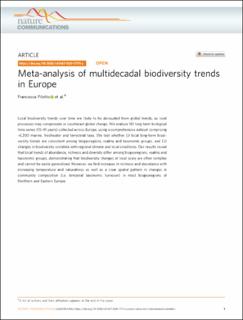Meta-analysis of multidecadal biodiversity trends in Europe
Pilotto, Francesca; Kühn, Ingolf; Adrian, Rita; Alber, Renate; Alignier, Audrey; Andrews, Christopher; Bäck, Jaana; Barbaro, Luc; Beaumont, Deborah; Beenaerts, Natalie; Benham, Sue; Boukal, David S.; Bretagnolle, Vincent; Camatti, Elisa; Canullo, Roberto; Cardoso, Patricia G.; Ens, Bruno J.; Everaert, Gert; Evtimova, Vesela V.; Feuchtmayr, Heidrun; García-Gonzále, Ricardo; Gómez García, Daniel; Grandin, Ulf; Gutowski, Jerzy M.; Hadar, Liat; Halada, Lubos; Halassy, Melinda; Hummel, Herman; Huttunen, Kaisa-Leena; Jaroszewicz, Bogdan; Jensen, Thomas Correll; Kalivoda, Henrik; Schmidt, Inger Kappel; Kröncke, Ingrid; Leinonen, Reima; Martinho, Filipe; Meesenburg, Henning; Meyer, Julia; Minerbi, Stefano; Monteith, Don; Nikolov, Boris P.; Oro, Daniel; Ozoliņš, Dāvis; Padedda, Bachisio M.; Pallett, Denise; Pansera, Marco; Pardal, Miguel Ângelo; Petriccione, Bruno; Pipan, Tanja
Peer reviewed, Journal article
Published version

Åpne
Permanent lenke
https://hdl.handle.net/11250/2670975Utgivelsesdato
2020Metadata
Vis full innførselSamlinger
- Publikasjoner fra CRIStin - NINA [2397]
- Scientific publications [1423]
Originalversjon
10.1038/s41467-020-17171-ySammendrag
Local biodiversity trends over time are likely to be decoupled from global trends, as local processes may compensate or counteract global change. We analyze 161 long-term biological time series (15–91 years) collected across Europe, using a comprehensive dataset comprising ~6,200 marine, freshwater and terrestrial taxa. We test whether (i) local long-term biodiversity trends are consistent among biogeoregions, realms and taxonomic groups, and (ii) changes in biodiversity correlate with regional climate and local conditions. Our results reveal that local trends of abundance, richness and diversity differ among biogeoregions, realms and taxonomic groups, demonstrating that biodiversity changes at local scale are often complex and cannot be easily generalized. However, we find increases in richness and abundance With increasing temperature and naturalness as well as a clear spatial pattern in changes in community composition (i.e. temporal taxonomic turnover) in most biogeoregions of Northern and Eastern Europe.
